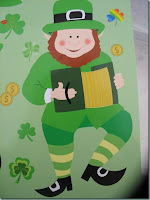My photo of a Saint Patrick statue
Holy Cross Cemetery, Brooklyn, New York
When everyone celebrates Saint Patrick's Day around the world on March 17th with parades, leprechauns, shamrocks, corned beef and cabbage, and green beer, etc, it can be easy to forget that this day is the feast day of a real man who, for the most part, lived and died in Northern Ireland around the early part of the 5th century, and converted the then pagan Irish natives to Christianity.
My photo of a St. Patrick Statue
Church of St. Joseph
Brooklyn, New York
When Saint Patrick was around 14 years old he was kidnapped from his Scottish homeland by Irish raiders and sold into slavery in Ireland. He was forced to work as a shepherd for six years, living under harsh conditions and suffering hunger and cold. Patrick turned to God for help as he wrote:
"The love of God and his fear grew in me more and more, as did the faith, and my soul was roused, so that, in a single day, I have said as many as a hundred prayers and in the night, nearly the same." "I prayed in the woods and on the mountain, even before dawn. I felt no hurt from the snow or ice or rain."
Saint Patrick
Holy Cross Cemetery, Brooklyn, New York
He eventually escaped through divine intervention and returned to his homeland, where he entered the priesthood and rose to the position of Bishop. Patrick had many visions of the people of Ireland begging him to return:
"I saw a man coming, as it were from Ireland. His name was Victoricus, and he carried many letters, and he gave me one of them. I read the heading: "The Voice of the Irish". As I began the letter, I imagined in that moment that I heard the voice of those very people who were near the wood of Foclut, which is beside the western sea—and they cried out, as with one voice: "We appeal to you, holy servant boy, to come and walk among us."
St. Patrick, Church of St. Joseph, Brooklyn, New York
Legend has it that Saint Patrick used a three leaf shamrock to explain the Holy Trinity to the Irish people, using its three leaves to symbolize the concept of three divine persons of God: the Father, Son and Holy Spirit. He left a particularly strong impression in Ulster, especially in the Downpatrick area, although at the time of his death he had not yet converted the whole island and was still subject to persecution. After nearly thirty years of missionary work he died on March 17, 461, and according to tradition, was buried at Downpatrick.
I was very fortunate last year to be able to visit Downpatrick, one of Ireland's most ancient and historic towns, when I was on a trip to Belfast, Northern Ireland last April of 2011. You can read about that trip, and others I've made to Ireland, if you scroll through my Ireland label here.
In Downpatrick I visited The Saint Patrick Centre, located at 53A Market Street, Downpatrick, County Down.
The Centre is an exciting interpretative exhibition which tells the fascinating story of Ireland's Patron Saint through Patrick's own words, as you can see in the photo mosaic above. A series of interactive displays allow visitors to explore how Patrick's legacy developed in early Christian times and enjoy the fabulous artwork and metalwork which was produced during this Golden Age.
The highlight of my visit to Downpatrick was in the grave yard of Down Cathedral, which is part of the Church of Ireland. It stands on the site of a Benedictine Monastery, built in 1183. Unfortunately, the church was not open on my visit, but interior photo links can be found at the bottom of this web page.

Slightly behind, and to the side of the church, on Cathedral Hill, is the graveyard.
There, on the crest of a hill overlooking the town of Downpatrick, lies the remains of Saint Patrick in a grave located under this slab of granite from the nearby Mourne Mountains.
On top of his marker were a few dried out bouquets of flowers that may have been laid there a month before, on his feast day last year.
I read the inscribed placard that says the remains of Saint Brigid and Saint Columba are also interred in this cemetery.
Tears came to my eyes as I touched the stone.
I was so touched and grateful to see the final resting place of the Saint whose name I bear, and in the country of some of my ancestors. This was one of the most memorable and spiritual sights of all I've seen in Ireland!
I'm linking this post to the following upcoming blog events:
Pink Saturday (Green for St. Patrick's Day!)
and
Thank you to all the blog hosts!
Have a very
















